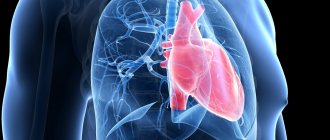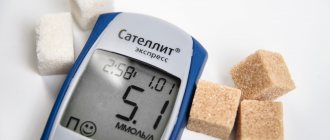What is diabetes mellitus? And what types is it?
Diabetes mellitus is a term that unites a group of diseases accompanied by an increase in glucose (sugar) in the blood. There are many different types of diabetes, but the main two are:
- Type 1, insulin-dependent
- it is also called “childhood” or “young people’s diabetes”, since it mainly affects children or young people; - Type 2, non-insulin dependent
- it is called “diabetes of the elderly”, since it is more common in older people. However, recently it has been diagnosed in young people and even children.
What to do if you have type 2 diabetes?
Important! If appropriate symptoms appear, you should immediately consult an endocrinologist and undergo a medical examination. The sooner the disease is detected, the faster it will be possible to get rid of it.
If a doctor has diagnosed diabetes mellitus, then for effective treatment it is necessary to strictly adhere to the recommendations of the endocrinologist and to constantly monitor your condition with special care.
Experts advise people suffering from type 2 diabetes to change their habits, diet, and maybe even lifestyle. Self-control plays a key role in this case.
The main recommendations are as follows:
- Constantly monitor glucose levels;
- monitor body weight;
- eat right, including low-calorie foods in your diet;
- exercise regularly, gradually increasing the load;
- increase preventive measures to prevent colds;
- maintain foot hygiene.
At the Family Clinic you can be examined by an endocrinologist. If the diagnosis is made along with diet and exercise, the doctor may prescribe a complex of oral hypoglycemic drugs. Constant monitoring of blood sugar and the patient's response to diet therapy allows the doctor to adjust treatment by prescribing drugs that increase the body's ability to effectively use its own insulin or increase its production.
Periodic visits to an endocrinologist for type 2 diabetes mellitus are mandatory, and its frequency is determined by the doctor, based on the patient’s condition. You can make an initial appointment with an endocrinologist by calling the number provided.
What is the etiology of diabetes mellitus?
The etiology is not exactly known.
But one of the reasons for the occurrence of diabetes is that the risk of the disease can be inherited. But this does not mean that if one of your family members has diabetes, then your child will definitely have it. Or, on the contrary, it may be that neither the mother, nor the father, nor the grandparents had diabetes, but the child was diagnosed with it. Diabetes mellitus can occur for various reasons: childhood infections and viral colds, as well as stress in children who have an increased predisposition to this disease. Moreover, the impact of these factors can occur long before the first signs of diabetes appear. Type 1 diabetes occurs because the body does not have enough insulin .
As a result, blood sugar levels increase.
Read also
Diffuse nodular goiter, autoimmune thyroiditis, hypothyroidism
Chronic autoimmune thyroiditis, hypothyroidism, thyroid nodules.
Thyroid diseases are a common problem in iodine-deficient regions (which include Samara... Read more
Metabolic syndrome
Metabolic syndrome is a “pandemic of the 21st century.” The prevalence of metabolic syndrome is 20–40%. In the Russian Federation, 40% of the population have 2 components of metabolic syndrome, 11% –...
More details
Hyperparathyroidism
Physiology of the parathyroid glands The parathyroid glands produce parathyroid hormone, the main hormone that regulates the metabolism of calcium and vitamin D (under the influence of parathyroid hormone, vitamin D becomes active)…
More details
Diabetes mellitus, type 2
Diabetes mellitus (DM) is a group of metabolic diseases characterized by chronic hyperglycemia, which results from impaired insulin secretion, insulin action, or both...
More details
Thyrotoxicosis (hyperthyroidism)
Physiology of the thyroid gland: The function of the gland is to synthesize and secrete thyroid hormones. An increase in their number leads to more intense metabolism and vice versa. Thyroid function is regulated...
More details
What are the symptoms of diabetes?
One of the first symptoms of diabetes is frequent urination
. Due to the fact that the child begins to go to the toilet frequently, gets up at night, becomes thirsty, and begins to drink more liquid. Parents usually notice that the child begins to drink a lot of water. Due to the fact that the sick child drinks and eats a lot, he begins to lose weight. Next, weakness and fatigue appear.
How is diagnosis carried out? Childhood diabetes is fairly easy to diagnose. We measure blood and urine glucose levels, as well as ketone levels.
How dangerous is this disease?
This disease is associated with a lack of insulin in the body.
And the only treatment so far is the administration of this hormone. Since insulin was invented only in the 20s of the 20th century, in former times children with diabetes died. If insulin is not administered at the right time, glucose cannot enter the cell. Insulin, like a key, opens the entrance to the cell for glucose. Our body uses glucose as energy, like fuel for a car. Thanks to this we move, breathe, work, think. If there is no main source of energy - glucose, then our body begins to draw energy from other sources: proteins and fats, which is why children lose weight. And when fat is used as energy, many harmful substances are formed that poison the child’s body ,
which can lead to death.
Does its clinical picture differ from diabetes mellitus in adults? In type 1 diabetes, the pancreas produces almost no insulin. In type 2 diabetes, insulin in the blood may even be increased, but due to a decrease in the sensitivity of body cells to insulin, its action is impaired. Most often this occurs due to obesity.
Well, the symptoms, as a rule, are exactly the same: frequent urination, thirst.
Are there any pre-diabetic conditions that would suggest a problem? In children, this is often an acute process. If pancreatic cells produce insulin in sufficient quantities, then there is no increase in blood glucose. Childhood diabetes occurs when less than 10% of insulin-producing cells remain.
Who is at risk? Hard to tell. For childhood diabetes there is no such thing as a risk group - it can “shoot” in any child ,
in any family.
Of course, the risk of developing diabetes is higher for those who have a family history of the disease. But, as I already said, this does not mean that it will necessarily develop. Also, premature babies and children born with low birth weight are more susceptible to this disease, as well as children who are bottle-fed and those who already have some kind of autoimmune disease. Parental smoking can play an unfavorable role.
Cardiac problems of patients with diabetes mellitus
Report by Professor Drapkina O.M., read at the II International Internet Congress of Internal Medicine Specialists (February 15, 2013).
Professor Drapkina O.M.: – I’ll move on to my report.
(00:03) Screensaver: Cardiac problems in a patient with diabetes.
Professor Drapkina O.M.: – And I’ll try to highlight a cardiologist’s view of the problem in patients with diabetes. And I want to say right away that, almost without exaggeration, we can state that this is a cardiovascular disease. And the statistics confirm this.
It should be noted that everything we know in general about cardiovascular risks and cardiovascular outcomes: heart attack, stroke, sudden death, coronary heart disease - is many times higher in patients with diabetes.
There is a very interesting study that says that if a patient has already had a myocardial infarction, but does not have diabetes, then the rate of recurrent myocardial infarction will be 18.8%. And if we have a patient diagnosed with diabetes mellitus and no myocardial infarction, then his risk of recurrent myocardial infarction will be even higher. This means that we can logically come to the conclusion that the presence of diabetes mellitus is more significant for recurrent myocardial infarction than a previous cardiovascular accident. And the risk doubles in cases where the patient already has diabetes mellitus and has already had a myocardial infarction. We can say that type 2 diabetes mellitus takes days to form, then years and decades. But still, the patient goes through several of these fundamental points.
At first this is the norm, then it is a very important moment when we can already determine impaired glucose tolerance. And, in the end, everything turns into type 2 diabetes. In this case, insulin secretion can be compensated for a long time, and only at the stage of impaired glucose tolerance can we see and “grasp” increased insulin secretion. And then comes the stage of so-called insulin insensitivity, when sensitivity to insulin decreases somewhat. This increases glucose tolerance in the same way as fasting glucose. And the patient demonstrates hyperglycemia, decreased glucose tolerance, decreased sensitivity to insulin, or, let’s say, it is not the receptor that is actually to blame for insulin resistance, but a violation of the intracellular signal, and hyperinsulinemia, and then a lack of pancreatic beta cells.
But we, as practicing doctors, of course, need to know the basic criteria for diabetes mellitus: fasting plasma glucose - more than 7 mmol/l. If there is any doubt, a glucose tolerance test should be performed. And after it, glucose should be within the range of more than and equal to 11.1 mmol/l. If plasma glucose is detected more than 11.1 mmol/l at any time, then patients have symptoms of diabetes mellitus and, finally, an increase in the level of glycosylated hemoglobin - more than 6.5%.
I would like to say a few words about the normal physiology of glucose metabolism. We understand that food, especially carbohydrates, when absorbed, causes blood glucose to increase. All this mediates a signal to the pancreas, which is responsible for normal insulin production. And normally produced insulin will cause blood glucose levels to instantly normalize.
If insulin resistance occurs - the very first part with which diabetes mellitus begins, then not only the production of insulin changes first - this is indeed the case, and then other processes also change. For example, excess fat breakdown occurs, which leads to an increase in free fatty acid levels.
And this is where the cascade of reactions begins, which Tatyana Evgenievna already spoke about today. Free fatty acids rush through the portal vein directly to the liver, and there the formation of, as we say, primary insulin resistance occurs. In addition, insulin-dependent glucose uptake into muscles is reduced. And it is at the muscle level, as some experts believe, that secondary insulin resistance occurs.
Thus, we can say that insulin resistance is the body's response to maintain insulin levels above its normal values to ensure normoglycemia. Consider the insulin receptor, which consists of two alpha subunits and two beta subunits. We can see that these subunits are connected using special bonds. And, in principle, if this receptor functions normally, then intracellular signal transmission mechanisms occur. And if suddenly at some stage, and most often the stage of implementing metabolic effects suffers by reducing the activity of phosphatidylinositol 3-kinase, which makes it impossible to activate the GLUT4 transporter, then the situation turns out that there is a lot of glucose and insulin in the cell. But at the same time, the signal that will ensure the transport of glucose directly into the cell does not fully occur.
Insulin resistance and non-alcoholic fatty liver disease is a “chicken or the egg – which comes first” situation? If you look at the insulin receptor, consisting of two subunits, then visceral fat: lipolysis, pro-inflammatory cytokines lead to the production of a large amount, for example, tumor necrotizing factor alpha (TNF-?), of free fatty acids, the processes of serine phosphorylation change insulin receptor residues (IRS1). And we see that the phosphatidylinositol 3-kinase pathway is blocked, which makes it impossible for the production and normal activity of the GLUT4 transporter. Today I am faced with the task of looking at the problem of diabetes mellitus from the cardiological “window”. And we see that everything that a cardiologist encounters: hypertension, dyslipidemia, the risk of thrombosis or thrombophilic status, renal dysfunction, microalbuminuria - these are all logical consequences of insulin resistance, and all of these are processes that do not just increase cardiovascular risk, and this is a patient with cardiovascular risk.
Thus, to summarize the first part of my message, I want to say that diabetes mellitus and the risk of cardiovascular diseases are inexorably linked - this is both macrovascular risk and microvascular risk. Speaking about macrovascular risks, we see a patient with a spectrum of problems: heart failure, myocardial infarction, stroke, arterial hypertension. Such a patient is also at risk of microvascular risks: retinopathy, nephropathy, neuropathy and erectile dysfunction.
I would like to briefly discuss the three main problems of a patient with diabetes mellitus: atherosclerosis, arterial hypertension and heart failure. Of course, the discussion about how to normalize glycemic levels is very attractive, since now, after all, the hypothesis of ultra-tight control of blood glucose levels has not lived up to the expectations that were placed on it, especially after the ACCORD study. However, I will not touch on this issue.
So, atherosclerosis. It is absolutely clear that a patient with diabetes has an increased level of low-density lipoproteins and an increased level of total cholesterol. But not only the increase in low-density lipoprotein levels in itself has prognostic significance. These lipids definitely change their properties - they are small, under-oxidized low-density lipoproteins, which are extremely virulent and which very quickly penetrate the subendothelial space and form a plaque. What type of plaque it will be: stable or unstable depends on many factors. But the presence of high LDL, high triglycerides and total cholesterol makes the atherosclerotic changes that a patient with diabetes exhibits very recognizable.
Postulating, we can say that the main features of atherosclerosis in diabetes mellitus are the following signs. This atherosclerosis begins early - about 8-10 years earlier compared to those who, for example, do not have diabetes. It is recognized even at the stage of impaired glucose tolerance. It progresses quickly and is polysegmental in nature. And as always, atherosclerosis is localized not only in large vessels, but also in vessels of medium diameter.
Depending on the level of low-density lipoproteins, high-density lipoproteins and triglycerides, we can say that patients with diabetes will also have a different risk of coronary heart disease. And, naturally, it will be higher in those with LDL levels more than 130 mg/dL, and HDL levels less than 35-45 mg/dL in men and in women who meet this risk.
Please note that triglyceride levels may be more than 400 mg/dL. And in this case, of course, we always keep in mind the possibility of developing so-called pancreatogenic pancreatitis. We can probably be relatively calm if our patient with diabetes has an LDL level of less than 100 mg/dL, an HDL level of more than 45-50 mg/dL and triglycerides of less than 200 mg/dL.
There are recommendations from the American Diabetes Association that were released in 2012. And I would like to say a few words about them, because, in my opinion, they are very convenient and well remembered. And, besides, dear colleagues, you will always have the opportunity to watch the lectures and once again refresh your memory of everything we talked about today.
Experts recommend that, regardless of baseline lipid levels, statins should be prescribed to patients with overt coronary heart disease. Regardless of baseline lipid levels, statins should be prescribed to patients over 40 years of age without CAD who have one or more risk factors for CAD.
For patients at lower risk, statins are prescribed when LDL levels are more than 2.6 mmol/L. And in patients without coronary artery disease, LDL levels should be below 2.6 mmol/L. In high-risk patients with coronary heart disease (and we say that most often patients with diabetes mellitus are already very high-risk patients), here, of course, the target figure is somewhat different - it is less than 1.8 mmol/l.
We continue to follow these recommendations. The next point in them is the following postulate: an alternative goal of reducing LDL, if we cannot achieve these “magic” numbers - 2.6 and 1.8 mmol/l, then we must try to reduce low lipoprotein levels by at least 40% from the initial level density. The target triglyceride level is below 1.7 mmol/L. The target level for high-density lipoproteins is more than 1.0 mmol/L in men and more than 1.3 mmol/L in women.
Finally, the combination of statins with other lipid-lowering drugs is being considered. There isn't much choice here at all. There was such a very attractive hypothesis, which, of course, has a right to exist - these are statins plus fibrates. Indeed, when hypertriglyceridemia is severe, fibrates are the drugs of choice in patients with diabetes mellitus. But again, after the ACCORD study, this concept did not show an impact on the prognosis of these patients. Therefore, the medical community is now looking for new combinations.
The hypothesis of combining statins with certain “hepatoprotectors”, which essential phospholipids can show themselves to be, is very attractive. Statins should be prescribed, as evidenced by large, large randomized studies.
But let's summarize what the analysis of the problem of atherosclerosis gives us. So our goal: LDL is less than 70 g/dL, diabetes is equivalent to CAD, and aggressive LDL control is needed, which will influence morbidity and mortality.
I would like to say a few more words about arterial hypertension. Arterial hypertension has a number of features in patients with diabetes mellitus. And, of course, hyperinsulinemia, which occurs in response to insulin resistance, contributes to this feature. This hyperinsulinemia is extremely aggressive because it leads to overactivation of the sympathoadrenal system, activation of the renin-angiotensin-aldosterone system, and sodium retention.
And this means that in the combination (necessarily combined) therapy of a patient with diabetes mellitus and arterial hypertension there will be diuretics, because this is volume-dependent arterial hypertension, there will be drugs that reduce sympathoadrenal activity and the activity of the renin-angiotensin-aldosterone system. The important thing is that there are some peculiarities here too.
The HOT study demonstrated that at the same level of diastolic blood pressure, the risk of developing cardiovascular accidents is greater in patients with diabetes, although the level of diastolic pressure is exactly the same. This suggests that we should probably be more skeptical or more aggressive in reducing diastolic and systolic blood pressure in patients with diabetes.
Let us turn to the recommendations of experts, who tell us that it is necessary to mentally change the lifestyle of a patient with a systolic blood pressure of up to 139 mm Hg. and diastolic – up to 89 mm Hg. All this happens over the course of three months. If lifestyle changes do not help within three months, you should resort to antihypertensive drugs. Well, if the systolic blood pressure when the patient comes to you is 140 and 90 mm Hg or more, then antihypertensive therapy is immediately indicated. In this case, the appointment of either an ACE inhibitor or an ARA is indicated. If one class is intolerable, another is prescribed. Combination therapy is usually needed to achieve target levels. And you definitely need to monitor kidney function, that is, look at the glomerular filtration rate, potassium level and creatinine level.
Another feature of arterial hypertension in such patients is the rigidity of the vascular wall. Vascular wall stiffness is an independent predictor of overall and cardiovascular mortality. In order to say that the rigidity of the vascular wall is the process from which arterial hypertension may begin, I want to say that the speed of the pulse wave is of great importance.
Our vessels are tubes, and if they are more rigid, then the wave of blood that left the left ventricle and hit the walls of the aorta or small vessels will return back at a higher speed. And we see that if the return wave is superimposed on the wave of blood exiting the aorta into the left ventricle, this leads to an increase in pulse pressure. An increase in pulse pressure, in turn, leads to a very unpleasant phenomenon - augmentation of pulse waves. If the patient has diabetes - and, as a rule, this is combined with non-alcoholic fatty liver disease - expect endothelial dysfunction. And it statistically significantly more often affects patients with diabetes.
We did a lot of research. We had many patients with obesity, insulin resistance, and diabetes. And it turned out that even if your patient is not yet hypertensive, then by conducting daily blood pressure monitoring (ABPM), you will identify a circadian disorder in him, a violation of the daily blood pressure profile. At night there will not be a sufficient reduction in blood pressure, which means that this not yet hypertensive patient will become hypertensive, which will naturally require drug therapy. Thus, another study proving that the stiffness of the vascular wall, which was measured by increasing pulse wave speed, has its place.
Why do blood vessels become stiff? Yes, because there is fibrosis. Remember, this is where we started today: the renin-angiotensin-aldosterone system and fibrosis are inextricably linked. And if we remember those observations that explain the pathogenesis of arterial hypertension in patients with diabetes mellitus, then we will also remember the activity of the sympathoadrenal system and the activity of the renin-angiotensin-aldosterone system. This means that this also needs to be addressed. There are parallels in the development of fibrosis of the liver and heart.
If we look at the clinical predictors of the development of fibrosis and cirrhosis, the cardiologist will exclaim: “Oh my God, these are known risk factors for the development of cardiovascular diseases: age, body weight, diabetes mellitus, nonspecific inflammation!” And we are looking at clinical predictors of the development of liver fibrosis and cirrhosis. “What is good for the heart is also good for the liver” - this postulate is becoming more and more firmly established in our lives.
It is guided by these reflections that we are now conducting research called “Result”. These are patients with arterial hypertension, with a high risk according to SCORE - more than 5%. And, it is clear that we treat them as expected. And it is necessary to treat arterial hypertension, and it is necessary to treat their atherosclerosis.
But in one case we added Rezalut to atorvastatin, and in the other case we did not, that is, we divided all patients into two groups. And according to these preliminary data, it turned out that before and after therapy, of course, the results of cholesterol and low-density lipoprotein levels differ significantly - atorvastatin did its job. Together with Rezalut he made it a little better. But this did not reach statistical significance, but the augmentation index decreased statistically significantly. That is, the vascular wall of these patients became a little more elastic. And this is statistically significant in the group of atorvastatin with Rezalut.
And in conclusion, I want to say that heart failure in these patients is also special, and it is again associated with fibrosis. They may also have unaffected coronary arteries, and pain may be caused by extravasal compression of the coronary arteries. These patients usually have microangiopathic changes in the venules and capillaries of the heart. And, in addition, these patients have supraventricular rhythm disturbances in both men and women. And this suggests that atrial fibrillation occurs much more often in patients with diabetes.
So, we have a very specific treatment goal: glycosylated hemoglobin - less than 6.5%, blood pressure - less than 130/80 mmHg, low-density lipoprotein level - less than 1.7 mmol/l and high-density lipoprotein level - more 1.2 mmol/l. I think the goals have been set. And we will wait for that “beautiful distant future” when we will be able to influence the processes of fibrosis.
What is the prognosis for treatment?
With proper and well-chosen treatment, the prognosis is favorable.
There are different types of insulin. Many children use insulin pump therapy. But it is important to know that much here depends not on the treatment, but on how the child and his parents perceive the diagnosis and how they treat it. They will have to learn a lot. The first thing is to streamline your diet
and lifestyle. Please note that the diet does not change completely, it just becomes correct. And this is not just eating chips, chocolates and sandwiches.
Secondly, in childhood diabetes mellitus, blood glucose control
. Children do this often: optimally 6–8 times a day. There are now many different means to control blood glucose. First of all, these are glucometers, when for each measurement of glucose in the blood the child needs to prick his finger. But now there are systems where a sensor is placed in children for two weeks (for example, in the shoulder area). And with a special device (scanner) you can determine blood glucose every minute by bringing this scanner to the sensor. And then you don’t need to prick your fingers 6–8 times a day.
Is a full life possible, and why will you have to give up forever? And our children live full lives
. Participate in various competitions and competitions. I would say, on the contrary, they are smarter and more capable than children without diabetes. Probably because they had to grow up earlier. Learn to lead a healthy lifestyle, eat right, and maintain a proper daily routine. They count bread units (this is the amount of carbohydrates) in order to correctly inject themselves with the required dose of insulin.
However, children with diabetes and their parents should be aware that they will be faced with the difficult question of choosing a profession. The fact is that some professions are contraindicated for diabetes:
- with heavy physical activity (miners);
- with significant neuropsychological stress (air traffic controllers, transport drivers);
- with irregular working hours, at night, with an unfavorable microclimate, with contact with toxic substances (chemical production).










